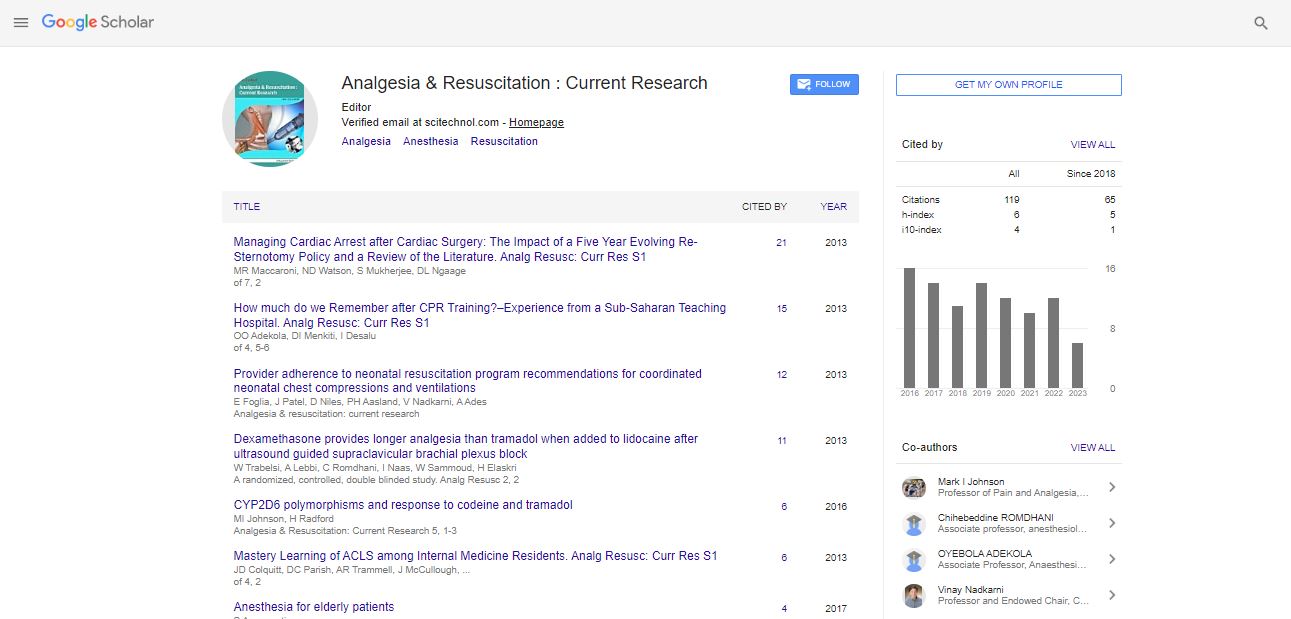Facilitating synthesis, axonal and cell surface trafficking of EP4 receptor and TRPV1 channel contributes to PGE2-induced nociceptor sensitization and transition from acute to chronic pain
Weiya Ma
McGill University, Canada
: Analg Resusc: Curr Res
Abstract
Chronic pain is an unmet clinical need which severely deteriorates the quality of life of individuals and imposes heavy financial burden on the health care system. Its treatment is rather challenging due to the unclear underlying mechanism. Growing evidence indicates that peripheral (nociceptor) and central sensitization caused by inflammatory mediators plays an essential role in the genesis of chronic pain. Pain mediator prostaglandin E2 (PGE2) abundantly produced in inflamed tissues is known to sensitize dorsal root ganglion (DRG) neurons and potentiates sensitizing effects of other pain mediators such as capsaicin and its receptor, transient receptor potential vanilloid-1 (TRPV1). We hypothesized that facilitating the long-term synthesis, axonal and cell surface trafficking of PGE2/EP4 receptor and capsaicin/TRPV1 channel in DRG neuronsis involved in nociceptor sensitization and transition from acute to chronic pain. In cultured DRG neurons, PGE2 and EP4 agonist increased cell surface trafficking of EP4 receptor and TRPV1 channel, events mediated through PKA and PKC signaling transduction pathways and coupled with enhanced nociceptive activities of EP4 and TRPV1. In a model of transition from acute to chronic pain, pre-exposure to PGE2 prolonged mechanical allodynia evoked by subsequent PGE2 or capsaicin challenge. This event was blocked by pre-injection of EP4 antagonist. Intraplanar (i.pl.) injection of PGE2 increased the levels of EP4 and TRPV1 in DRG neurons, sciatic nerves and plantarskin, which was suppressed by co-injection of EP4 antagonist. In inflammatory pain models, i.pl.co-injection of COX2 inhibitor or EP4 antagonists with carrageenan or complete Freud’s adjuvant blocked or shortened mechanical allodynia evoked by subsequent PGE2 challenge. Inflammation-increased EP4 and TRPV1 in DRG neurons were reversed by COX2 inhibitor or EP4 antagonists. These data suggest facilitating synthesis, axonal trafficking and cell surface trafficking of EP4 and TRPV1 through PGE2/EP4 signaling contributes to nociceptor sensitization and potentiation as well as transition from acute to chronic pain.
Biography
Weiya Ma completed her PhD from Dept of Pharmacology and Therapeutics at McGill University, Canada. After finishing two Postdoctoral Fellowships in Canada, she went to Wake Forest University in States to take a Faculty position in Dept of Anesthesiology. Then she moved back to Canada to continue her research at Douglas Mental Health University Institute. Now she is an Assistant Professor at Dept of Psychiatry, McGill University. She has published novel studies unraveling the role of neuropeptides in nociception, neuropathic pain and morphine tolerance. Her pioneer work exploring the role of inflammatory mediator PGE2 in the genesis of chronic pain has let her become a leader in this field. She was frequently invited to present her work at seminars, to contribute review articles and book chapters to introduce her research works. Her research has been supported by Canadian Institutes of Health Research and Natural Sciences and Research Council of Canada
 Spanish
Spanish  Chinese
Chinese  Russian
Russian  German
German  French
French  Japanese
Japanese  Portuguese
Portuguese  Hindi
Hindi 
